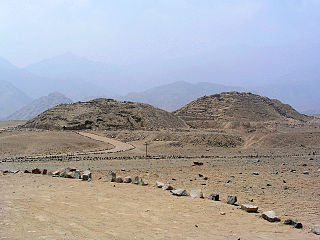
The Andean preceramic refers to the early period of human occupation in the Andean area of South America that preceded the introduction of ceramics. This period is also called pre-ceramic or aceramic.

The Andean preceramic refers to the early period of human occupation in the Andean area of South America that preceded the introduction of ceramics. This period is also called pre-ceramic or aceramic.
The earliest humans that came to South America are known as Paleo-Indians. This period is generally known as the Lithic stage. After this came the period that is widely known as Archaic, although there are also some different classifications of this period. The precise classification is complicated because somewhat different terminologies tend to be used for North America and Mesoamerica.
The Andean preceramic period would include cultures that belong to Lithic and Archaic stages.
The Zaña Valley in northern Peru contains the earliest known canals in South America. These were small stone-lined canals which drew water from streams in the Andes Mountains region. These canals may have been built as early as 4700 BC.
A great deal of archaeological work has been done in Peru in relation to the preceramic cultures, and while Caral/Norte Chico civilization has now been studied extensively, there are also many other sites being studied.

Caral/Norte Chico is one of the most notable and well-studied cultures in Peruvian archaeology. The most impressive achievement of this civilization was its monumental architecture, including large earthwork platform mounds and sunken circular plazas. Also, these preceramic peoples built massive irrigation and water management projects.
Archaeological evidence suggests a very early use of textiles, and in particular the use of cotton. Also, recent studies (2013) indicate that maize played a significant role in this civilization starting as early as 3000 BC, contrary to previous findings. Beans and sweet potato were grown as well. [1]
Caral/Norte Chico sites are notable for exceptional collective density, as well as individual size. Haas argues that the density of sites in such a small area is globally unique for a nascent civilization. During the third millennium BC, Caral/Norte Chico may have been the most densely populated area of the world (excepting, possibly, northern China). [2] The Supe, Pativilca, Fortaleza, and Huaura River valleys each have several related sites.

Caral is an important center of this civilization. The city was inhabited between 2600 and 2000 BCE, [3] enclosing an area of more than 60 hectares. [4]
Caral was first fully documented and analyzed by Dr. Ruth Shady Solís and other Peruvian archaeologists in the late 1990s. [5] A 2001 paper in Science , providing a survey of the Caral research, [6] and a 2004 article in Nature , describing fieldwork and radiocarbon dating across a wider area, [7] revealed Norte Chico's full significance and led to widespread interest. [8]
As a result, Caral/Norte Chico has pushed back the horizon for complex societies in the Peruvian region by more than one thousand years.
Huaricanga, also in the Norte Chico region, is believed to be the earliest city of this civilization, and thus it would have been the oldest city in the Americas. It existed around 3500 BCE." [9]
Besides the lack of pottery, a remarkable feature of this civilization is the apparent absence of any artistic or religious symbolism. Or at least they have not been identified so far.
Nevertheless, there is evidence for the worship of certain deities, such as the Staff God, a leering figure with a hood and fangs. The Staff God is a major deity of later Andean cultures, and it has been suggested that its use so early points to the worship of common symbols of gods for a long period of time. [10] [11]

Sophisticated government is assumed to have been required to manage the ancient Caral/Norte Chico. Questions still remain over its organization, particularly the influence of food resources on politics.
Some scholars suggested that Norte Chico was founded on seafood and maritime resources, rather than on the development of an agricultural cereal and crop surpluses, as has been considered essential to the rise of other ancient civilizations. Yet now these views are being revised because of strong evidence for maize consumption.
Several major preceramic archaeological sites are located in the valleys of the Casma River and its tributary the Sechin River. The largest among them is Sechin Alto; the other big mounds are Sechin Bajo, Mojeque, Cerro Sechin, Las Haldas and several others. The dates for these sites start at c. 3600 BCE.
The Kotosh Religious Tradition is a term used by archaeologists to refer to the ritual buildings that were constructed in the mountain drainages of the Andes between circa 3000 and c.1800 BCE, during the Andean preceramic. [1]
Archaeologists have identified and excavated a number of these ritual centers; the first of these to be discovered was that at Kotosh, although since then further examples have been found at Shillacoto, Wairajirca, Huaricoto, La Galgada and Piruru. [2] These sites are all located in highland zones that are lower than the Puna, and yet there are considerable distances separating them. In spite of this, all these cases of highland preceramic public architecture are remarkably similar. [3]

El Paraiso, Peru is a very large early center in the Ancón-Chillón Valley, that may be somewhat related to the Norte Chico tradition. It is approximately from the same time frame as the above. It is just one of the six major preceramic sites in the Ancón-Chillón Valley, including Ancon (archaeological site).
Another important site is Bandurria, Peru, on the Huaura River, featuring monumental architecture that may go back to mid-fourth millennium BC.
In the northern peruvian coast stand out sites such as Huaca Prieta, were the earliest recorded use of indigo dye to date was found and Huaca Ventarron, its painted murals are the oldest discovered in the Americas.
In Ecuador, the Preceramic period is believed to have started around 9000 BC, and lasted until around 4200 BC. According to Jeffrey Quilter, Ecuador yielded plentiful evidence of early dense occupations of the highlands that is so far not found either in Peru or in Bolivia. [12]
Along the Pacific Coast, the Las Vegas culture predominated, while up in the mountains, it was the Inga culture.
The Las Vegas culture is the first known culture in Ecuador. They lived on the Santa Elena Peninsula on the coast of Ecuador between 9000–6000 BC. The skeletal remains and other finds preserve much evidence of this culture.
Scientists have classified three phases of cultural development. The earliest people were hunter-gathers and fisherman. Approximately 6000 BC, these peoples were among the first to begin farming; among their early crops were bottle gourd, Lagenaria siceraria , and an early type of maize, Zea mays L. [13]
El Inga peoples lived high in the mountains near present-day Quito, the capital of Ecuador. Evidence from the archeological site El Inca date the culture to 9000–8000 BC. Excavations were undertaken around 1961. It is believed that, from the archaeological perspective, this area is one of the most important in South America, and it may have existed along an ancient trade route.[ citation needed ]
Some of the tools used by these early nomadic hunters have provided relationships to the Clovis culture "Level I" at Fell's Cave in southern Chile, and technological relationships to the late Pleistocene "fluted point" complexes of North America. [14]

El Abra is an important early human settlement site in Colombia with a large cave system. Its investigation started in 1967, and the stratigraphy of lithic instruments, bones and vegetal charcoal with radiocarbon dating established the date of the settlement in 12,400 BP ± 160 years. [15] Other preceramic archaeological sites are Tibitó (11,850 BP), Tequendama, dated to 11,000 years BP, Checua (dated to 8500 BP), Aguazuque (5000 BP) and El Infiernito , dated to 4900 years BP. [16] [17] [18] [19]
The earliest cultures of Bolivia are the Wankarani culture, and the Chiripa. The earliest Wankarani sites are dated from 1800 BC onwards. [20] Wankarani culture arose in the area of the current Oruro Department in Bolivia near Lake Poopo. The Wankarani had developed a copper metallurgy by 1200 B.C.
The area of the Altiplano close to Bolivia yielded the earliest evidence of metalworking in South America. This is the site of Jisk'a Iru Muqu, also spelled Jiskairumoko, in the Lake Titikaka basin, which was first investigated in 1994. A necklace consisting of nine gold beads was found in an excavated grave located next to a Terminal Archaic pit-house. Charcoal recovered from the burial dates the gold beads to 2155-1936 cal BC [21]
Some of the early preceramic cultures flourished both in Peru and in Chile. This applies to the Chinchorro culture that was active in what is now northern Chile and southern Peru. This culture left us the Chinchorro mummies; these are the oldest examples of artificially mummified human remains in the world. The oldest mummy recovered from the Atacama Desert is dated around 7020 BC. [22] This tradition is believed to have reached a peak around 3000 BC.

A cradle of civilization is a location and a culture where civilization was created independent of other civilizations in other locations. The formation of urban settlements (cities) is the primary characteristic of a society that can be characterized as "civilized". Other characteristics of civilization include a sedentary non-nomadic population, monumental architecture, the existence of social classes and inequality, and the creation of a writing system for communication. The transition from simpler societies to the complex society of a civilization is gradual.

In Andean Iconography front-facing figures are often referred to as Staff Gods and thought to represent deities in Andean cultures. There is no uniform representation of a "Staff God". Dozens of variations of "Staff Gods" exist. Usually a Staff God is pictured "front-facing" holding vertical objects one in each hand. Some scholars think that some variations of the Staff God are possible depictions of Viracocha or Thunupa.

The Sacred City of Caral-Supe, or simply Caral, is an archaeological site in Peru where the remains of the main city of the Caral civilization are found. It is located in the Supe valley of Peru, near the current town of Caral, 182 kilometers north of Lima, 23 km from the coast and 350 metres above sea level. It is attributed an antiquity of 5,000 years and it is considered the oldest city in the Americas and one of the oldest in the world. No other site has been found with such a diversity of monumental buildings or different ceremonial and administrative functions in the Americas as early as Caral. It has been declared a Humanity Cultural Heritage site by UNESCO.

The Chinchorro mummies are mummified remains of individuals from the South American Chinchorro culture, found in what is now northern Chile. They are the oldest examples of artificially mummified human remains, having been buried up to two thousand years before the Egyptian mummies. The earliest mummy that has been found in Egypt dated around 3000 BCE, while the oldest anthropogenically modified Chinchorro mummy dates from around 5050 BCE.
Peruvian territory was inhabited 14,000 years ago by hunters and gatherers. Subsequent developments include the appearance of sedentary communities that developed agriculture and irrigation, and the emergence of complex socio-political hierarchies that created sophisticated civilizations, technology and monumental construction.
Huaricanga is the earliest city of the Norte Chico civilization, called Caral or Caral-Supe in Peru and Spanish language sources. "It existed around 3500 BC and was the oldest city in the Americas and one of the earliest cities in the world." This Late Archaic site is located in the arid Fortaleza Valley on Peru’s north central coast. It is 14 mi (23 km) inland from the Pacific Ocean. The site covers a total area of 100 hectares, and is the largest Late Archaic construction in the Norte Chico region.

Caral-Supe was a complex pre-Columbian-era society that included as many as thirty major population centers in what is now the Caral region of north-central coastal Peru. The civilization flourished between the fourth and second millennia BC, with the formation of the first city generally dated to around 3500 BC, at Huaricanga, in the Fortaleza area. It is from 3100 BC onward that large-scale human settlement and communal construction become clearly apparent, which lasted until a period of decline around 1800 BC. Since the early twenty-first century, it has been established as the oldest-known civilization in the Americas, and as one of the six sites where civilisation separately originated in the ancient world.
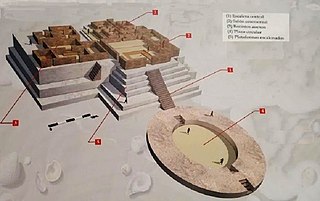
Aspero is a well-studied Late Preceramic site archaeological complex located near the mouth of the Supe River, south of Supe Puerto, on the central coast of Peru. It forms part of the ancient Caral-Supe civilization and was occupied during the Late Archaic period, from before 3000 BCE to around 1800 BCE. It is connected culturally to the ancient city of Caral, located 25 km up-valley, for which it presumably served as a major fishery. The site covers an area of approximately 14 hectares and features numerous temples or huacas, of which the most prominent are the Huaca Alta, the Huaca de los ídolos and the Huaca de los Sacrificios. Remains of human sacrifice have been found in the latter, dated to about 4500 years ago.

Cerro Sechín is an archaeological site in Casma Province of Ancash Region in northern Peru. Dating to 1600 BC, the site was discovered by Peruvian archaeologists Julio C. Tello and Toribio Mejía Xesspe on July 1, 1937. Tello believed it was the capital of an entire culture, now known as the Casma/Sechin culture or Sechin complex. Notable features include megalithic architecture with carved figures in bas-relief, which graphically dramatize human sacrifices. Cerro Sechín is situated within the Sechin Alto Complex, as are Sechin Bajo, and Taukachi-Konkan. There is a small on-site museum. The slabs at Cerro Sechin may represent the central Andes' oldest known monumental sculpture.
Aceramic is defined as "not producing pottery". In archaeology, the term means "without pottery". Aceramic societies usually used bark, basketry, gourds and leather for containers.

The Andean civilizations were South American complex societies of many indigenous people. They stretched down the spine of the Andes for 4,000 km (2,500 mi) from southern Colombia, to Ecuador and Peru, including the deserts of coastal Peru, to north Chile and northwest Argentina. Archaeologists believe that Andean civilizations first developed on the narrow coastal plain of the Pacific Ocean. The Caral or Norte Chico civilization of coastal Peru is the oldest known civilization in the Americas, dating back to 3500 BCE. Andean civilization is one of the six "pristine" civilizations of the world, created independently and without influence by other civilizations.
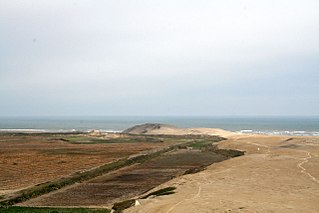
Huaca Prieta is the site of a prehistoric settlement beside the Pacific Ocean in the Chicama Valley, just north of Trujillo, La Libertad Province, Peru. It is a part of the El Brujo Archaeological Complex, which also includes Moche (culture) sites.

The history of human habitation in the Andean region of South America stretches from circa 15,000 BCE to the present day. Stretching for 7,000 km (4,300 mi) long, the region encompasses mountainous, tropical and desert environments. This colonisation and habitation of the region has been affected by its unique geography and climate, leading to the development of unique cultural and socn.
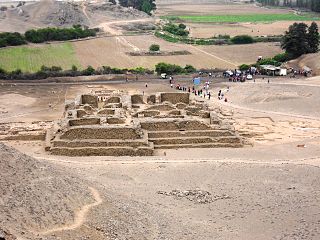

Sechin Bajo is a large archaeological site with ruins dating from 3500 BCE to 1300 BCE, making it not only one of the oldest centers of civilization in the Western Hemisphere, but also one of the oldest civilization centers on earth. Sechin Bajo is located in the valley of the Sechin River, about 12 kilometres (7.5 mi) from the Pacific Ocean and about 330 kilometres (210 mi) northwest of Lima, Peru. Sechin Bajo is one ruin among many located in close proximity to each other in the valleys of the Casma and Sechin Rivers.

Las Haldas or Las Aldas is a large archaeological complex from before and during the initial ceramic period of Peru. Las Haldas is located on the Pacific coast approximately 300 kilometres (190 mi) north of Lima and about 20 kilometres (12 mi) south of the Casma river valley, noted for the extensive ruins of the Casma–Sechin culture. For most of its history Las Haldas, a coastal community, coexisted with the inland agricultural communities in the Casma River Valley.

The Casma–Sechin culture of Peru refers to the large concentration of pre-historic ruins in the valleys of the Casma River and its tributary the Sechin River and along the nearby coast of the Pacific Ocean. The ruins include major archaeological sites such as Sechin Bajo, Sechin Alto, Cerro Sechin, Mojeque, Chankillo, and Taukachi-Konkan, as well as other smaller sites. Most of these inland sites are found in the river valleys about 20 kilometres (12 mi) distant from the ocean. The seaside sites of Huaynuná and Las Haldas are found about 20 kilometres (12 mi) north and south of the mouth of the Casma River on the coast.

Bandurria is a large archaeological site on the Huaura River in Peru that has been dated to 4,000 BC. It is located about 3 km south of the city of Huacho, in Huacho District, Huaura Province, Lima Region. It corresponds chronologically to the period known as the 'Late Archaic' or 'Late preceramic' covering the years from about 4000 to 2000 BC.

Tequendama is a preceramic and ceramic archaeological site located southeast of Soacha, Cundinamarca, Colombia, a couple of kilometers east of Tequendama Falls. It consists of multiple evidences of late Pleistocene to middle Holocene population of the Bogotá savanna, the high plateau in the Colombian Andes. Tequendama was inhabited from around 11,000 years BP, and continuing into the prehistorical, Herrera and Muisca periods, making it the oldest site of Colombia, together with El Abra, located north of Zipaquirá. Younger evidences also from the Herrera Period have been found close to the site of Tequendama in Soacha, at the construction site of a new electrical plant. They are dated at around 900 BCE to 900 AD.
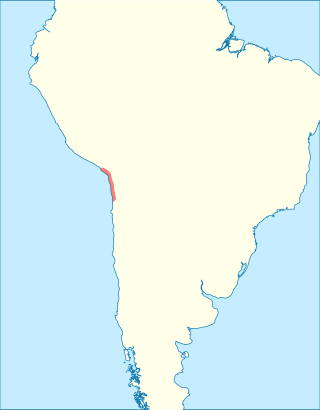
The Chinchorro culture of South America was a preceramic culture that lasted from 9,100 to 3,500 years BP. The people forming the Chinchorro culture were sedentary fishermen inhabiting the Pacific coastal region of current northern Chile and southern Peru. Presence of fresh water in the arid region on the coast facilitated human settlement in this area. The Chinchorro were famous for their detailed mummification and funerary practices. The area of the Chinchorro culture started to receive influences from the Andean Plateau around 4,000 BP, which led to the adoption of agriculture. Much later, it came under the influence of the Tiwanaku Empire.